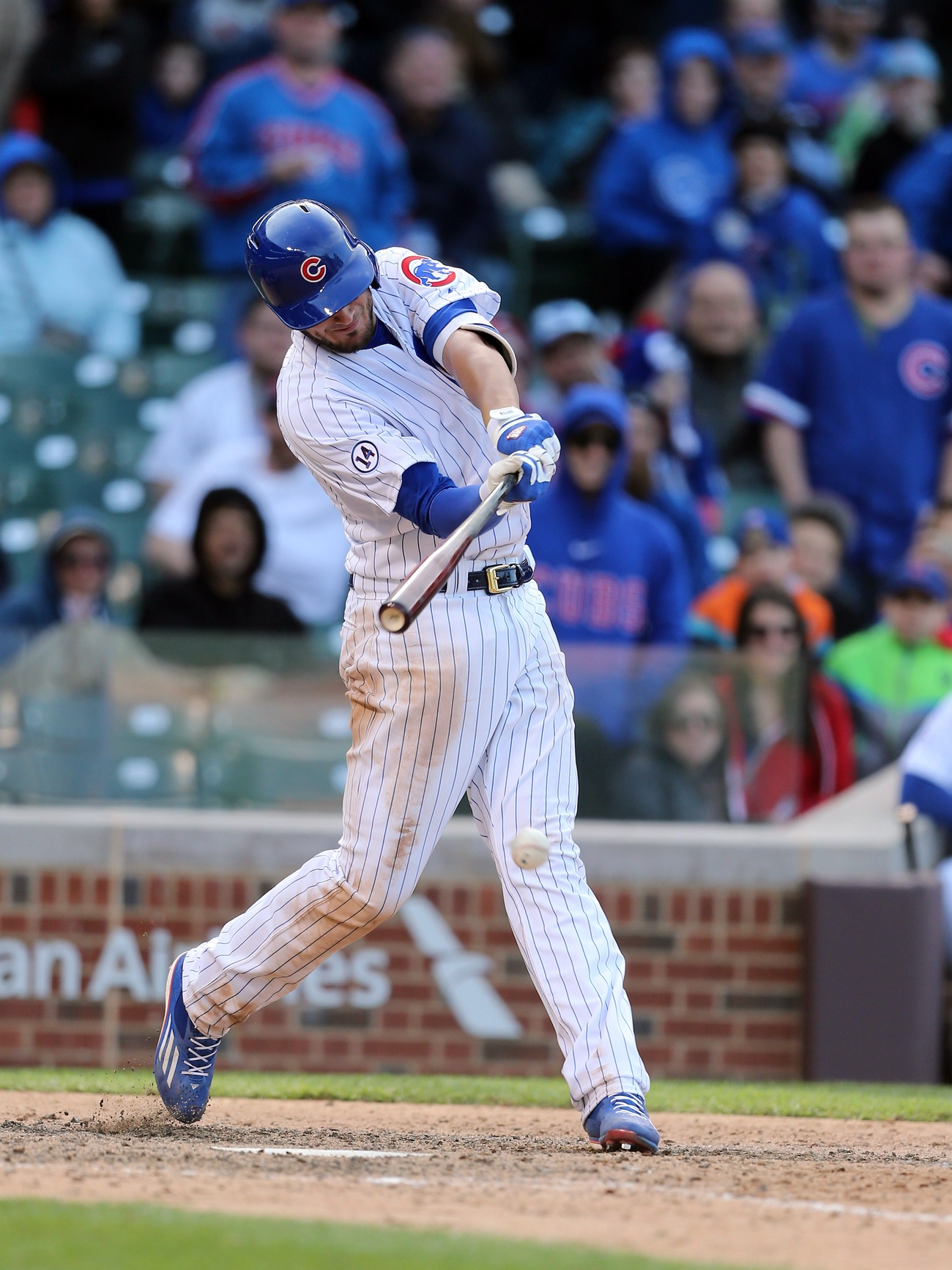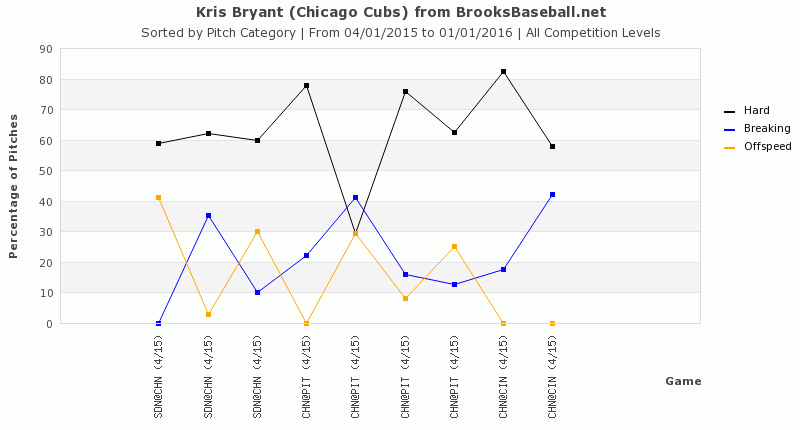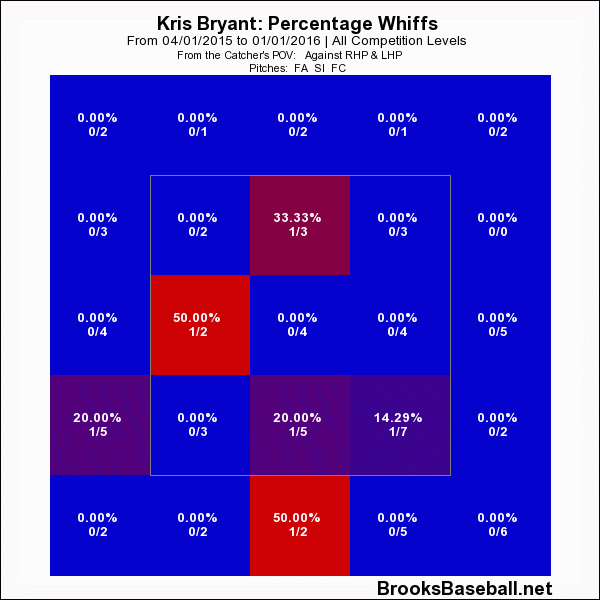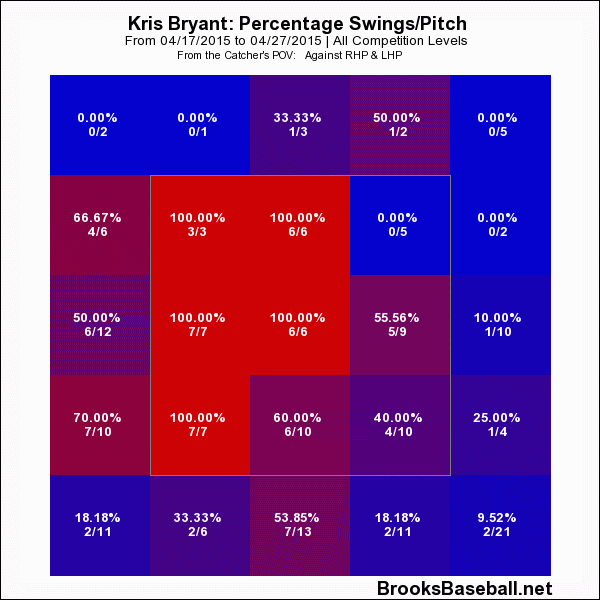Photo courtesy of Dennis Wierzbicki-USA TODAY Sports
At this point the saying is old hat, but we’ve been spoiled by tremendous debuts and perhaps we’ve been particularly spoiled by the greatness that is Mike Trout. Making the transition to the majors is a tough ride fraught with developmental hurdles, adjustments, re-adjustments, and re-adjustments to the re-adjustments. It’s just not supposed to look as easy as Trout makes it appear.
With that in mind, I decided to take a deep dive into Kris Bryant’s initial exposure to the major leagues. The focus of this article is to illustrate where pitchers have tried to attack Bryant compared to what his perceived strengths and weaknesses were. It’s a small look into the initial exposure prospects have to the highest level of baseball.
Before we dive in, let’s get a refresher course on Bryant the prospect.
Bryant entered the 2014 as the no. 17 prospect in baseball (as ranked by the dearly departed Jason Parks). The best bat in the 2013 draft was coming off an impressive debut where he slugged .688 across three lower-level assignments, backing up the assumption that his advanced bat was ready for advanced competition.
Here’s Parks on what was ahead for Bryant in 2014:
Bryant is ready to start his first full season at the Double-A level, and with any luck, he will be forcing the issue at the major-league level at some point in 2014. The power is enormous and is going to play at the highest level, although he might end up hitting for a lower average and swinging and missing more than some are projecting. While the 22-year-old can play passable defense at the hot corner, his athleticism and arm are a better fit for right field, a position most sources seem to agree is Bryant’s long-term home. Regardless of where he plays, the bat could make him an all-star, a true 35-plus home run force in the middle of a lineup.
Bryant shot up the rankings as he laid waste to the upper minors to the tune of a .325/.438/.661 line across Double- and Triple-A. Bryant was foreshadowing the power even during his days as an amateur player. Here’s David Rawnsley from Perfect Game on Bryant’s power:
One thing that Bryant could do back at Bonanza High School was, not surprisingly, hit for power. He started his swing from a fairly high hand position for a long, power-oriented swing and generated tremendous back spin on the ball from his swing plane.
…
While Bryant’s first two collegiate seasons were very strong (.365-9-36 as a freshman, .366-14-57 as a sophomore), they merely set the stage for his junior year. At a time in college baseball when players just weren’t hitting home runs and entire teams barely broke double figures in long balls, Bryant hit 31 home runs all by himself despite getting walked 66 times in 57 games.
The in-game power showed up almost immediately upon his arrival to pro ball, as Bryant showed off an advanced approach and made a strong case for a call-up. His impressive 2014 resulted in him being ranked no. 5 by the Prospect Team at Baseball Prospectus and a torrid spring made it clear Bryant’s bat was ready for the major-league test. Of course, due to the much-debated service time issue, Bryant wasn’t called up until after the Cubs were guaranteed an extra year of control. For now, we can move past the controversy, focus on the fact that Bryant is here and watch an immensely talented player learn at the highest level.
Bryant isn’t perfect; there’s a prevalent set of weaknesses that tend to accompany every report on the player.
This is Parks again from the 2014 list:
Weaknesses: Hit tool could limit full utility of power tool; can get tied up inside by quality stuff; bat path/plane limits time in the zone; sources suggest more swing-and-miss to come against better arms; lower half actions can get stiff at third; lacks first-step quickness /ideal range.
And here is Nick J. Faleris from this year’s list:
Weaknesses: Long levers produce holes in swing that could be attacked by major-league arms; limited swing plane/pitch plane overlap narrows contact margin; some issues with velocity on inner half; capable at third base but may lack lower-half agility to excel; run could settle a tick below average at maturity.
So with those quotes, we have a pretty solid idea of the strengths and the weaknesses of one of the top young bats in the game. Bryant possesses elite power potential, and when he gets his arms extended the power actualizes in visceral, scary ways. He has a patient, advanced approach and he’s shown some issues with velocity on the inner half throughout his career as a function of his long arms. Combine it with the upper-cut power plane he has and you have a player who will have some natural swing and miss to his game. Bryant is also big for a third baseman, so the ultimate defensive home is still up in the air, though the arm is plenty strong for the hot corner or in right field.
With the basic profile set, let’s focus on the bat and see how pitchers were attacking him.
Bryant’s match-up in his debut against James Shield sticks out for a few reasons. The changeup is a feel pitch and it’s rarely mastered at the minor-league level. For the most part, the change is refined and mastered against major-league hitters and as such I’m willing to bet a lot that Bryant hasn’t seen a change like Shields’ in regular season game action. BP’s Jordan Gorosh wrote up a scouting report on Shields’ changeup this past offseason:
Outstanding arm speed and deception. Prefers to throw to LHH, will also use on RHH. Fading and tumbling action with arm-side drop. Acts like a forkball. Bat-missing offering, very difficult to square up. Will work backwards when deeper in count. Rarely starts hitters off with the pitch. Flashes 80, can be an elite offering. Money pitch. Bread and butter. Primarily thrown with two strikes, especially to LHH. Uses to get strike outs.
It’s a tough match up for any major leaguer, let alone a rookie—even one as refined as Bryant. The first at-bat went poorly:
Welcome to the bigs, rook. Perhaps the above result can be attributed to first-game jitters, but either way, this is a very tough match-up for Bryant, and it’s doubly effective in that Shields does a great job in setting up Bryant for future at-bats. This is something that rookies have to learn on the job. Pitchers can reach the majors on stuff, but the ones who last as starters have the ability to set batters up from at-bat to at-bat. Shields did exactly that in Bryant’s first plate appearance, not needing to display much of his strong repertoire—he has a fastball and a curveball that he didn’t have to use at all in Bryant’s first at-bat.
Shields was aggressive with the change, and in general pitchers have been aggressive with the off-speed stuff against Bryant early in his career.
There’s a pretty big reason for that—mainly that it’s been the only effective plan of attack against Bryant so far. But before we get to that, let’s revisit something the scouting reports have all said during Bryant’s ascension through the minors. When it comes to both the hit tool and, by extension, the power tool’s in-game utility, we keep coming back to the inherent swing and miss present in Bryant’s game. The key factors for this are two-fold: Bryant’s power swing plane leaves little room for error when it comes to making contact and Bryant’s long limbs can leave him exposed to velocity on the inner half. It was the key point of focus when it came to the “weaknesses” category for the two Top 10s Bryant appeared on. So how is Bryant handling fastballs inside?
Bryant hasn’t been missing many fastballs early on either:
Bryant has done a particularly good job of getting his hands around on the fastball. Yes, he loves to get his arms extended, but thus far, he’s belied the scouting reports and demonstrated an impressive ability to hit velocity in. In fact, he hasn’t missed much at all when it comes to the fastball:
|
Whiff Percentage |
|||
| Year | Hard | Breaking | Off-speed |
| 2015 | 7.79 | 13.79 | 33.33 |
Through ten games, Bryant has shown the judicious eye and advanced approach he’s always been praised for, with his eight walks (17.4 percent walk rate) on the young season being just one of many representations of that trait. And even if we include his rough debut, when he went 0-for-4 with three strike outs while swinging at numerous pitches out of the zone, Bryant is still showing remarkable selectivity thus far.
We’ve seen an initial adjustment to a concern about velocity on the inner half, as well as an ability to barrel the baseball, especially when he can get his arms extended. We’ve also seen a new potential weakness. In the table above you’ll see the rather large number underneath “Off-speed.” The changeup has been a pain for Bryant during his initial week-plus in the majors, it’s going to be a tough pitch to adjust to, and likely one more pitchers will try to use against him as his scouting report makes the rounds. There are only a few good changeups out there, but even the average ones can disrupt a hitter’s timing. In additions to the issues with off-speed stuff, we’ve also yet to see the home-run power manifest itself yet in the bigs, but that will come soon enough. Generally, power can take a while to fully actualize at the highest level.
The big leagues are all about adjustments. The players who can make them thrive at the highest level. Bryant is a refined prospect, but at the end of the day, he’s still a rookie. The talent lends itself to hot streaks, like the one he’s currently on, but the adjustment period will likely lend itself to spots during which he’ll look bad. It’s part of the process, but to this point in his very young career, there are numerous reasons to believe that Bryant will have the ability to overcome the rough patches and look good for long, extended periods of time.




The one thing that caught me off guard about Bryant (despite hearing so much about him) was how willing he is to go to right field. Sometimes he looks Jeterish with that inside-out action, and that’s going to serve him well—especially in the early going of his MLB career.
He’s a legitimate hitter who might be able to squeeze out .280+ from the bat with power at maturity. Smart player.
…and a truly nice guy. His extended interactions with kids during spring training were impressive.